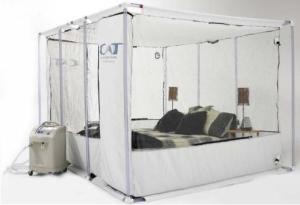Altitude has well established benefits for an athlete. Increased red blood cell production through increased erythropoietin (EPO) levels, results in a better ability of the blood to carry and deliver oxygen. Oxygen supply is one of the critical factors determining oxidative capacity and VO2max. At increasing altitude the partial pressure of oxygen decreases. This means that oxygen defusing from the lungs to the blood is reduced. Sensors in the body detect this reduction of oxygen dissolved in the blood. A series of physiological responses then act compensate. The magnitude and “shelf life” of these responses is dependant on the duration of exposure to a high altitude (hypoxic) environment. Most athletes therefore believe that the longer they stay at altitude the more beneficial it will be for them in terms of performance. A greater oxidative capacity is a major contributing factor in aerobic endurance and performance. While there is no doubt that altitude improves an athletes physiology and oxidative capacity, it may not always benefit athletic performance.
At altitude the poor supply of oxygen will make relative efforts more intense depending on the height above sea level. The higher an athlete goes the harder exercise at relative efforts will become. In some ways this is a benefit, as the athlete can improve both mentally and physiologically. With time it can also become a disadvantage. The athlete becomes accustomed to working at lower power outputs and pace in comparison to sea level. When they return to sea level they can struggle to maintain high pace even though they are physiologically capable. Technique and exercise efficiency can be greatly diminished by the time spent at altitude. For this reason an athlete will need to find a compromise between the physiological improvements and maintenance of technique. The live high, train low model is one such strategy which has shown success in overcoming this. An athlete will spend non training hours living in a hypoxic environment and will then return to sea level for training. They can also do this artificially by creating a hypoxic environment such as an “altitude house” or by sleeping in an “oxygen tent”. In either case the athlete is in an artificially controlled environment. They now can ensure sufficient duration in hypoxia to elicit a physiological response. They do not experience the issue with training intensity as they can complete their training at a sea level environment. When this method is adopted for a number of days or weeks the athlete can experience a significant overall improvement to aerobic performance. One exception to this theory is when an athlete is preparing for a competition that is at a high altitude venue. In this case the athlete must become acclimated to their competition environment. The loss in sea level performance is acceptable as the athlete must now focus his efforts around a performance in a new environment.

Depending on the goals and schedule of the athlete, altitude training can be a major benefit. Like with most training concepts there is a time and a place. Multiple factors must be considered in order to create an effective training strategy. We a constantly learning from science and real world experience. New technology such as oxygen tents can now allow us to make much better use of our knowledge of physiology and performance. Coaches and athletes should make a strong effort to stay informed about rapidly improving techniques.
